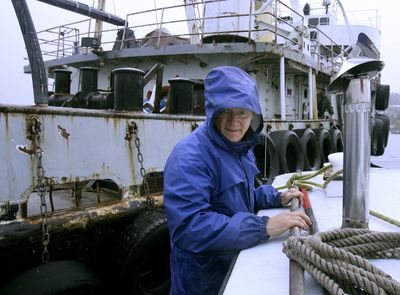World War II tugboat needs permanent home
Vessel could become museum, classroom

OLYMPIA – It has been a World War II Navy tug, a U.S. Coast Guard rescue ship and an oceangoing commercial tug in its 64-year history at sea.
Now it’s a veritable floating maritime museum owned by a nonprofit group, anchored in lower Budd Inlet and looking for a permanent home.
The Comanche – that was its name as a Coast Guard ship from 1959 to 1980 – moved to South Sound in January 2007, first moored at a Port of Olympia marine terminal, followed by a few-month stay anchored south of Gull Harbor and more recently, Butler Cove.
At 143 feet long, it’s hard to miss on the Budd Inlet waterfront. It’s one of the largest tug boats in Puget Sound and the last of a class of 89 large, seagoing auxiliary tugs commissioned by the Navy in 1944 to assist warships in theaters of action during World War II.
The Comanche served in the Okinawa war theater and earned a battle star for towing battle-damaged ships out of the line of fire.
“The Comanche and its crew saved hundreds of lives” during the war, said Joe Peterson, a former Coast Guardsman who served on the Comanche’s sister ship, the Modoc, which later was turned into a luxury yacht.
Peterson, a Tacoma resident and civilian instructor at Fort Lewis and McChord Air Force Base, formed a nonprofit group in 2007 called the Comanche 202 Foundation. The ship’s last owner, David Howard, of Toledo, donated the ship to the foundation after using it for about 15 years as a Tacoma-based oceangoing commercial tug, Peterson said.
The steel-hulled ship is filled with records, reports and maintenance logs dating to its Navy days, as well as about 13,800 spare parts in their original packaging, said Tom Payne, a diesel mechanic and foundation secretary who has donated countless hours working on the ship’s engine, which is operational.
The diesel electric power block aboard the vessel is reliable and powerful enough to generate electricity for a town of 5,000, Payne said.
The ship also is equipped with a fire-suppression system capable of delivering 2,000 gallons a minute.
The Comanche is memorable in other ways, said Randy Corrigan, a Lacey-area man who served on the ship for two years (1976-78) as a Coast Guard executive officer, second in command to the captain.
“It was the roughest-riding ship I was ever on in 27 years in the Coast Guard,” Corrigan said.
The stormy seas that the vessel faces in the years ahead have more to do with finding a home and funding to realize the foundation’s dream of a refurbished, 1960s vintage Coast Guard vessel open to the public and equipped to host programs on maritime survival, shipboard safety, seamanship and a training center for teaching nautical skills.
“We’re interested in Olympia as our home,” Peterson said. “Having a permanent berth here would be marvelous.”
Although its Coast Guard years were spent in the coastal waters of California and Texas, the ship did call on the Port of Olympia a number of times in more recent years as a commercial tug, Peterson said.
The Comanche and its supporters are typical of a lot of well-intentioned maritime history projects long on enthusiasm and short on money, noted Bob Peck, a Tumwater resident and president of the South Sound Maritime Association.
“It’s sort of a nostalgia thing,” Peck said. “But this historic vessel happens to be in unusually good condition. It’s not a derelict vessel. It’s fully operational, but it’s in everybody’s best interest to find it a home.”
Peterson said the vessel and its volunteers have been well-received in Olympia. The ship participated in Harbor Days Aug. 29-31 in downtown Olympia, hosting 1,200 visitors and raising $1,600.
A dedicated core group of foundation volunteers has donated 2,600 hours of labor on the ship in the past year, Peterson said.
At the same time, the ship has generated a number of complaints from lower Budd Inlet residents, who see it as interfering with their enjoyment and views of the waterfront, said Melissa Montgomery, who manages the state Department of Natural Resources derelict-vessel program.
The DNR ordered the Comanche to move from its anchorage over state tidelands south of Gull Harbor last summer, citing state law that it had overstayed its visit.
“We’re not treating it as a derelict vessel, but we’ve added it to our vessel watch list as one to keep an eye on,” she said.
Montgomery said her department hasn’t done the research, but the ship might still be perched over state tidelands, which means it may have to move again.
“We’re a little concerned; it’s pretty close to the shipping channel,” she said. “But we want to make sure they have a chance to raise the money they need and find a home.”